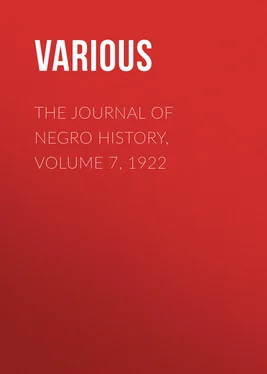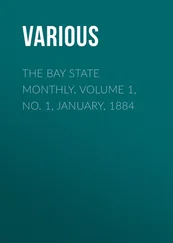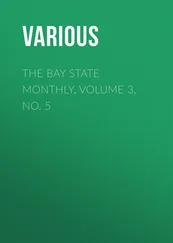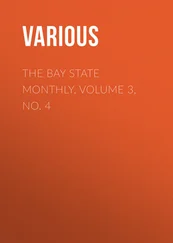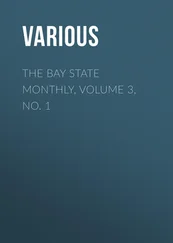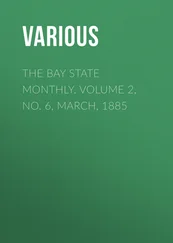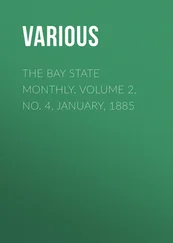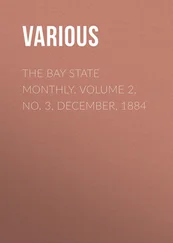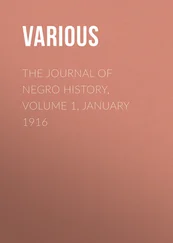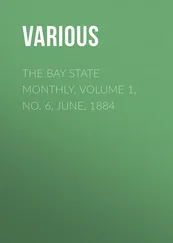Various - The Journal of Negro History, Volume 7, 1922
Здесь есть возможность читать онлайн «Various - The Journal of Negro History, Volume 7, 1922» — ознакомительный отрывок электронной книги совершенно бесплатно, а после прочтения отрывка купить полную версию. В некоторых случаях можно слушать аудио, скачать через торрент в формате fb2 и присутствует краткое содержание. Жанр: foreign_antique, periodic, История, foreign_edu, на английском языке. Описание произведения, (предисловие) а так же отзывы посетителей доступны на портале библиотеки ЛибКат.
- Название:The Journal of Negro History, Volume 7, 1922
- Автор:
- Жанр:
- Год:неизвестен
- ISBN:нет данных
- Рейтинг книги:3 / 5. Голосов: 1
-
Избранное:Добавить в избранное
- Отзывы:
-
Ваша оценка:
- 60
- 1
- 2
- 3
- 4
- 5
The Journal of Negro History, Volume 7, 1922: краткое содержание, описание и аннотация
Предлагаем к чтению аннотацию, описание, краткое содержание или предисловие (зависит от того, что написал сам автор книги «The Journal of Negro History, Volume 7, 1922»). Если вы не нашли необходимую информацию о книге — напишите в комментариях, мы постараемся отыскать её.
The Journal of Negro History, Volume 7, 1922 — читать онлайн ознакомительный отрывок
Ниже представлен текст книги, разбитый по страницам. Система сохранения места последней прочитанной страницы, позволяет с удобством читать онлайн бесплатно книгу «The Journal of Negro History, Volume 7, 1922», без необходимости каждый раз заново искать на чём Вы остановились. Поставьте закладку, и сможете в любой момент перейти на страницу, на которой закончили чтение.
Интервал:
Закладка:
The first head of this institution was James E. Campbell, a graduate of the Pomeroy High School. After laying the foundation and popularizing the work to some extent in the central portion of the State, Campbell resigned and was succeeded by J. H. Hill, who rendered very efficient service until 1899, when he was succeeded by J. McHenry Jones, under whom the school considerably expanded. Following him came Byrd Prillerman, a man beloved by the people of West Virginia. He had already been a successful teacher of English in this school. He then served the institution as president for ten years, emphasizing the high ideals of Christian character as the essentials in the preparation of youth. In 1915 a collegiate course was established at this institution and its name was changed to that of the West Virginia Collegiate Institute. In 1919 Byrd Prillerman was succeeded by John W. Davis, under whom the institution is progressing with renewed vigor in its new field as a reorganized college furnishing facilities for education not offered elsewhere for the youth of West Virginia.
The influx of Negroes into the southern counties of the State, which necessitated the establishment of many elementary schools, caused at the same time a demand for the extension of the facilities of pedagogic training of the advanced order provided in the West Virginia Colored Institute, which was not at first easily accessible to the people of southern West Virginia. Acting upon the memorials, praying that this need be supplied, the legislature established the Bluefield Colored Institute in 1895. Mr. Hamilton Hatter was made the first principal and upon him devolved the task of organizing this institution. After serving the institution efficiently until 1906 he retired, and was succeeded by Mr. R. P. Sims, who had formerly been an efficient and popular assistant under Mr. Hatter at this institution. Mr. Sims has acceptably filled this position until the present time.
The West Virginia Teachers' Association
To promote education and to encourage interest in their particular work the Negro teachers of the State soon deemed it wise to take steps for more thorough cooperation of the whole teaching corps of West Virginia. White and Negro teachers were then admitted to the same teachers' institutes and in certain parts were encouraged to participate in the general discussions; but believing that they could more successfully cooperate through organizations of their own, the teachers in Charleston, in 1891, appointed from their own reading circle a committee to organize a State Teachers' Association. This committee was composed of H. B. Rice, P. B. Burbridge and Byrd Prillerman. The meeting was invited by Byrd Prillerman, as secretary, to meet at the Simpson M. E. Church in Charleston. More than fifty teachers and race leaders attended. Inasmuch as H. B. Rice, the chairman of the committee, was absent on account of illness, P. B. Burbridge, whose name was second on the list of the committee, called the meeting to order, and delivered the address of welcome. William T. McKinney of Huntington was elected temporary chairman. The Association was then permanently organized by naming Byrd Prillerman its first president and Mrs. Rhoda Weaver its first secretary. Among the most important addresses was that of C. H. Payne, an influential and educated minister then engaged in religious and editorial work at Montgomery, and that of B. S. Morgan, State Superintendent of Public Schools. Others attending the meeting were Dr. W. T. Merchant, Mrs. E. M. Dandridge, Mrs. M. A. Washington-Thompson, F. C. Smith, and J. R. Jefferson. 54
The second meeting of this Association assembled according to arrangement in Parkersburg, West Virginia. The work of the Association had by this time been taken more seriously by the teachers throughout the State. They adopted a constitution with a preamble which stated that the aim of the Association was "to elevate the character and advance the interest of the profession of teaching, and to promote the cause of popular education in the State of West Virginia." An address was delivered by State Superintendent of Schools B. S. Morgan, and papers were read by Mrs. E. M. Dandridge of Quinnimont, Miss Blanche Jeffries of Charleston, Miss Coralie Franklin of Storer College, and Principal J. E. Campbell of the West Virginia Colored Institute. Among the persons attending but not appearing on the program were C. H. Barnett, who had been recently graduated by Dennison University in Ohio; C. H. Payne, then well known in the State of West Virginia; Dr. W. S. Kearney, a graduate of the medical college of Shaw University, then beginning his practice in Huntington; J. R. Jefferson, F. C. Smith and O. A. Wells. Booker T. Washington was at this time made an honorary member. Byrd Prillerman was unanimously elected president.
The third annual meeting of the Association was held at Parkersburg, West Virginia, in 1893. For some reason there were not many teachers present. It was held at the Baptist Church of that city, with President Byrd Prillerman presiding. The address of welcome was delivered by Mr. J. R. Jefferson, to the words of whom Mr. C. W. Boyd of Charleston responded. At this meeting Principal J. E. Campbell of the West Virginia Colored Institute was made president of the Association, with C. W. Boyd, J. R. Jefferson, Miss Mary F. Norman as vice-presidents, Miss Clara Thomas as secretary, Miss E. D. Webster as treasurer, and Mrs. Susie James as historian. Two of the most prominent persons participating in this meeting were J. McHenry Jones, then principal of the high school in Wheeling, and J. H. Hill, an instructor in the West Virginia Colored Institute.
The fourth annual meeting assembled at Montgomery. J. E. Campbell being absent, Professor C. W. Boyd presided. The meeting to a certain extent was a successful one. A Thanksgiving sermon was preached by Dr. C. H. Payne. Dr. H. F. Gamble read a paper on "Science in Common School Education." The Association took high ground by adopting a resolution urging a compulsory school law. A committee consisting of C. W. Boyd, Rev. G. B. Howard, J. W. Scott, John H. Hill, and Byrd Prillerman, was appointed to urge the State to make an appropriation for the teaching fund of the West Virginia Colored Institute. Byrd Prillerman was again elected President and Miss Fannie Cobb was chosen secretary.
The fifth annual meeting of the Association was held at Hinton. An important feature of the meeting was the method of entertainment, in that the citizens of Hinton gave the teachers a free banquet. Still more significant was the address delivered by Dr. J. E. Jones of the Richmond Theological Seminary. Byrd Prillerman, the President, himself delivered an important address giving valuable facts as to the conditions of the schools of the State, evoking widely extended comment. The most prominent persons attending were J. H. Hill, Principal of the West Virginia Colored Institute, G. B. Howard, Miss Mary Booze, W. T. McKinney, and Miss G. E. Fulks. 55
The sixth annual meeting was held in Charleston in the House of Delegates, November 26-27, 1896. This was the largest and most interesting meeting hitherto held. Welcome addresses were delivered by C. W. Boyd of the Garnet High School, Mr. George L. Laidley, Superintendent of the Charleston Public Schools, and Governor W. A. McCorkle. Responses to the words of welcome were delivered by J. H. Hill, principal of the West Virginia Colored Institute, Hamilton Hatter, principal of the Bluefield Colored Institute, and C. H. Payne. Other prominent persons who attended the meeting were Honorable V. A. Lewis, P. F. Jones, Colonel B. W. Byrne, Professor A. L. Wade, J. R. Jefferson, Rev. D. W. Shaw, Dr. G. W. Holley, P. B. Burbridge, Dr. H. F. Gamble, Dr. L. B. Washington, Mrs. E. M. Dandridge, Mrs. M. A. W. Thompson and Mrs. Byrd Prillerman. Officers elected were: President, Byrd Prillerman; Vice Presidents, J. R. Jefferson, Mrs. E. M. Dandridge, C. W. Boyd; Secretary, Miss Mary J. Jones; Treasurer, Mrs. M. A. W. Thompson; Historian, Mr. George L. Cuzzins.
Читать дальшеИнтервал:
Закладка:
Похожие книги на «The Journal of Negro History, Volume 7, 1922»
Представляем Вашему вниманию похожие книги на «The Journal of Negro History, Volume 7, 1922» списком для выбора. Мы отобрали схожую по названию и смыслу литературу в надежде предоставить читателям больше вариантов отыскать новые, интересные, ещё непрочитанные произведения.
Обсуждение, отзывы о книге «The Journal of Negro History, Volume 7, 1922» и просто собственные мнения читателей. Оставьте ваши комментарии, напишите, что Вы думаете о произведении, его смысле или главных героях. Укажите что конкретно понравилось, а что нет, и почему Вы так считаете.
